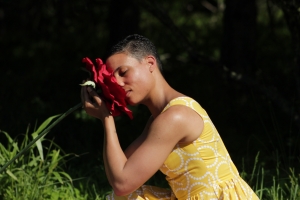Turchin Center for the Visual Arts
Friday, April 6 from 6 – 8 pm
Black Mountain College can be considered the incubator of mid-century avant-garde culture, even the birthplace of a new American avant-garde as it combined European modernism with American experimentalism. The curriculum at Black Mountain with its radical experiment in communal living, learning by doing, aesthetic principles and focus on ethics and creative democracy, was essential to the development of the arts and many of the counterculture movements in the second half of the twentieth century.
According to Black Mountain scholar Mary Emma Harris, the activity that had the greatest impact on art in America was the experimental performance staged by John Cage in the dining hall at Black Mountain in the late summer of 1952. At the time, no one involved called it a "Happening," and some even found the evening's activities slightly annoying, even boring. Cage was so distracted by the commotion he created that he left.1 On later reflection, Cage titled the discombobulated events of the evening, Theater Piece No. 1: it became known as the first "Happening," an important event to the development of avant-garde theater and performance art. Black Mountain College alumni, Fielding Dawson wrote about the night:
I was at the Happening in the summer of 1952, seated in a folding chair, with a few—not many—others, while Merce's dancers ran up and down stepladders, and whatever it was that was, occurred, heard from radios, were there two, or three? And dogs barked, children ran around, the composer himself at the piano doing whatever it was that he did in, and out, and on his instrument, in the Dining Hall by the lake that night, as frogs and crickets sang, and the stars looked down upon us. I thought the world had gone mad.2
In planning for the evening, Cage used chance procedures to assign each performer a time within which to enact a particular activity. Although Cage had a vague idea of what each participant would do, specific assignments were not given. We have followed this format in our evening at the Turchin Center for the Visual Arts, providing times and locations but not dictating specific assignments for the performers you will see during the evening. Since the early 1950s, Happenings and Performance Art events have become part of the artistic milieu not only in the United States but also throughout Europe and many major artistic centers around the world. While on the surface these performances may appear to be random with little purpose or function, they actually become opportunities for performers and audiences alike to free associate between apparently disparate artistic forms of expression. In that way, new modes of perception can "happen" in an environment that is often improvisatory. Philosopher Stephen T. Asma in his most recent book, The Evolution of Imagination, reminds us that in the improvisatory happening, "the imagination is our inner time-traveler."3 Happenings and Performance Art events provide us with opportunities to engage with art not as passive "consumers" but rather as active agents co-creating with the performers and with each other.
1 Harris, Mary Emma. The Arts at Black Mountain College. Cambridge & London: MIT Press, 1987. Pgs. 226 – 228.
2 Dawson, Fielding. Text first written for his Talk for Saturday, March 7, 1992 Education at Black Mountain and to be released in the forthcoming edition of the Appalachian Journal.
3 Asma, Stephen T. The Evolution of Imagination. Chicago: University of Chicago Press, 2017. Pg. 2.
SCHEDULE
Theater Piece #1 Revisited: A Happening
POETRY READINGS:
• Joseph Bathanti, Professor of English, former North Carolina Poet Laureate [Main Gallery @ 6 & 7]
• Daniel Jenkins, MFA candidate, Warren Wilson College [Mayer Gallery @ 6:15 & 7:15]
• Katrina Plato, art therapist, artist [Mayer Gallery @ 6:45 & 7:45]
• Roy Robbins, writer and poet [Mayer Gallery @ 6:30 & 7:30]
DANCE:
• A reading and dance performance by Jessica Wood, dance studies professor and Ray Miller, professor
in dance studies and theater arts of techniques by Erick Hawkins, who was a contemporary of Merce
Cunningham. [Main Gallery @ 6:30 & 7:30]
• An elevator dance performance by Marianne Adams, professor of dance studies featuring 3 SADE
student choreographers. [Big Elevator @ 6 & 7]
• An improvisational movement with Laurie Atkins, dance studies associate professor, and students
from her Modern III/IV technique class. [Mezzanine Gallery @ 6:15 & 7:15]
MUSIC:
• An improvisational musical tribute to John Cage and other contemporaries from the Black Mountain
experience by music professor, Rob Falvo. [Second Floor – near the Piano @ 6:00 & 7:00]
PERFORMANCE:
• A devised performance art piece exploring storytelling elements through time, space, and technology
with Adrien Rieder, a theatre artist, playwright, and faculty member in theatre and dance, and
graduate of The Juilliard School Drama Division; Murilo Artese, a junior from Sao Paulo, Brazil,
majoring in electronic media/broadcasting and minoring in english, and Jordan Bolick,
a senior theatre performance major.
[Main, Mezzanine and Community Galleries – ongoing performance, largely silent, 6 – 8]
FILM:
• Selected dance films from dance artist and curator for Movies for Movers, Cara Hagan.
[Media Room, just off the Community Gallery – ongoing screenings, 6 – 8 ]
Happening wrap-up and conversation, 8 - 8:30, Turchin Center Lecture Hall
All are welcome!
A special thanks to emcee, Ray Miller, Professor, Dance Studies & Theatre Arts
For additional information visit: tcva.org or cas.appstate.edu/black-mountain-college

